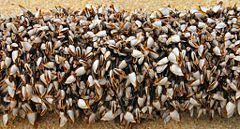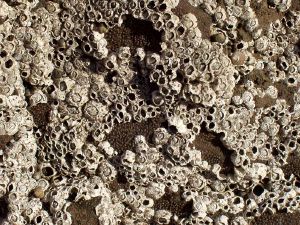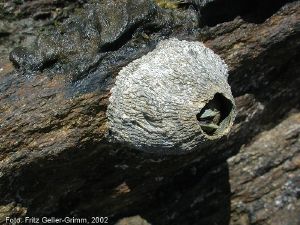Difference between revisions of "Barnacle" - New World Encyclopedia
Rick Swarts (talk | contribs) |
Rick Swarts (talk | contribs) |
||
| Line 30: | Line 30: | ||
[[Image:Gooseneckbarnacles.jpg|thumb|left|240px|''Pollicipes polymerus'', the gooseneck barnacle]] | [[Image:Gooseneckbarnacles.jpg|thumb|left|240px|''Pollicipes polymerus'', the gooseneck barnacle]] | ||
| − | Barnacles are generally placed into three or four subgroups. Martin and Davis (2001) place them into three subgroups, Thoracica, Rhizocephala, and Acrothoracica, | + | Barnacles are generally placed into three or four subgroups. Martin and Davis (2001) place them into three subgroups, Thoracica, Rhizocephala, and Acrothoracica, but some also recognize as barnacles the group Ascothoracida (Russell-Hunter 1969), which Martin and Davis consider as an infraclass outside the infraclass Cirripedia. '''Thoracica''' are the typical shell-forming barnacles; '''Rhizocephala''' consist of shell-less barnacles that are parasites on crabs and lobsters; '''Acrothoracica''' includes ectoparasites on [[whale]]s, [[turtle]]s, [[shark]]s, lobsters, and those that bore into shells of [[mollusk]]s or [[coral]]s; and [[Ascothoracida]] consists of species that are parasites on [[coelenterate]]s and [[echinoderm]]s. Russell-Hunter (1969) recognize a fifth major group, Apoda, consisting of a single genus that was discovered and described by Charles Darwin and that parastizes stalked barnacles. |
| − | The typical barnacles, all placed in Thoracica, include the stalked or gooseneck barnacles that attach to the substrate by means of a stalk and the acorn, or rock, barnacles that attach directly to the substrate. In both, initially the head is first fixed down to the substrate at [[metamorphosis]] by head appendages (antennules) with terminal suckers (Russell-Hunter 1969). The adult becomes permanently attached and uses six pairs of biramous, thoracic limbs as a food-catching mechanism (Russell-Hunter 1969). In the stalked barnacles, a | + | The typical barnacles, all placed in Thoracica, include the stalked or gooseneck barnacles that attach to the substrate by means of a stalk and the acorn, or rock, barnacles that attach directly to the substrate. In both, initially the head is first fixed down to the substrate at [[metamorphosis]] by head appendages (antennules) with terminal suckers (Russell-Hunter 1969). The adult becomes permanently attached as calcareous plates are secreted, and uses six pairs of biramous, thoracic limbs as a food-catching mechanism, with three to six pairs bieng involved (Russell-Hunter 1969). In the stalked barnacles, a fleshy stalk supports the head with calcified plates, while in an acorn barnacle the body is totally enclosed in calcareous plates secreted by the mantle (Russell-Hunter 1969). |
| − | |||
| − | + | In Acrothoracica, the least modified species, which retain a rough acorn barnacle shape, live as ectoparastites on whales, turtles, and so forth, and derive food through a [[root]] system into the host tissue (Russell-Hunter 1969). Other ectoparasitic members of Acrothoracica live in the [[gill]] cavities of lobsters and crabs, some parasites bore into the shells of mollusks. Some bore into coral or limestone rock and continue to use their thoracic appendages in feeding. | |
| + | In Rhizocephala, almost all members who are parasites on crabs and lobsters, the adult is merely a branching structure, like a [[fungus]], growing into the host tissue (Russell-Hunter 1969). They do not have an alimentary canal at any stage. | ||
| + | |||
| + | In Ascothoracida, the organisms are mostly embedded in host tissues (coelenterates and echinoderms), butthe mantle is enormously developed as an absorptive sac (Russell-Hunter 1969). | ||
==Life cycle== | ==Life cycle== | ||
Revision as of 16:59, 14 February 2007
| Barnacle | ||||||||||||
|---|---|---|---|---|---|---|---|---|---|---|---|---|
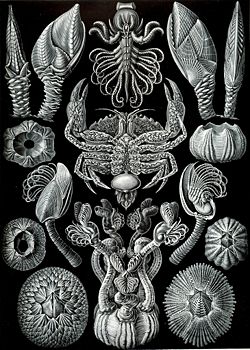 "Cirripedia" from Ernst Haeckel's Artforms of Nature, 1904. The crab at centre is nursing the externa of a parasitic cirripede of the genus Sacculina | ||||||||||||
| Scientific classification | ||||||||||||
| ||||||||||||
| Superorders | ||||||||||||
|
Acrothoracica |
Barnacles are exclusively marine, sessile crustaceans comprising the taxonomic group Cirripedia. Typical barnacles (stalked and acorn barnacles) are characterized by a calcareous shell, or carapace, but there are also naked barnacles without shells, including ones that parasitize other invertebrates and some that bore through shells and corals. Typical barnacles are distinguished from other crustacean groups (crabs, copepods, shrimp, etc.) by their entirely and permanently attached mode of existence.
Just as Crustacea is variously considered as a subphylum (of Arthropoda), phylum, superclass, or even class level (Hobbs 2003), Cirripedia is variously classified as an infraclass, class, or subclass. (See classification.)
Barnacles are a widespread and common marine group, with around 1,220 species currently known. They are among the most important of marine fouling organism, and can decrease the speed and increase the fuel consumption of ocean-going vessels (Russell-Hunter 1969).
Barnacles are distinguished by the fact that they were systematics and distribution was studied for a number of years by Charles Darwin, in his quest to further his ongoing development of the theory of evolution and natural selection.
The name "Cirripedia" means "curl-footed".
Characteristics
As with other crustaceans—crabs, lobsters, shrimps, copepods, krill, crayfish, etc.—barnacles are characterized by having branched (biramous) appendages, an exoskeleton made up of chitin and calcium, two pairs of antennae that extend in front of the mouth, and paired appendages that act like jaws, with three pairs of biting mouthparts. They share with other arthropods the possession of a segmented body, a pair of jointed appendages on each segment, and a hard exoskeleton that must be periodically shed for growth.
Barnacles are generally placed into three or four subgroups. Martin and Davis (2001) place them into three subgroups, Thoracica, Rhizocephala, and Acrothoracica, but some also recognize as barnacles the group Ascothoracida (Russell-Hunter 1969), which Martin and Davis consider as an infraclass outside the infraclass Cirripedia. Thoracica are the typical shell-forming barnacles; Rhizocephala consist of shell-less barnacles that are parasites on crabs and lobsters; Acrothoracica includes ectoparasites on whales, turtles, sharks, lobsters, and those that bore into shells of mollusks or corals; and Ascothoracida consists of species that are parasites on coelenterates and echinoderms. Russell-Hunter (1969) recognize a fifth major group, Apoda, consisting of a single genus that was discovered and described by Charles Darwin and that parastizes stalked barnacles.
The typical barnacles, all placed in Thoracica, include the stalked or gooseneck barnacles that attach to the substrate by means of a stalk and the acorn, or rock, barnacles that attach directly to the substrate. In both, initially the head is first fixed down to the substrate at metamorphosis by head appendages (antennules) with terminal suckers (Russell-Hunter 1969). The adult becomes permanently attached as calcareous plates are secreted, and uses six pairs of biramous, thoracic limbs as a food-catching mechanism, with three to six pairs bieng involved (Russell-Hunter 1969). In the stalked barnacles, a fleshy stalk supports the head with calcified plates, while in an acorn barnacle the body is totally enclosed in calcareous plates secreted by the mantle (Russell-Hunter 1969).
In Acrothoracica, the least modified species, which retain a rough acorn barnacle shape, live as ectoparastites on whales, turtles, and so forth, and derive food through a root system into the host tissue (Russell-Hunter 1969). Other ectoparasitic members of Acrothoracica live in the gill cavities of lobsters and crabs, some parasites bore into the shells of mollusks. Some bore into coral or limestone rock and continue to use their thoracic appendages in feeding.
In Rhizocephala, almost all members who are parasites on crabs and lobsters, the adult is merely a branching structure, like a fungus, growing into the host tissue (Russell-Hunter 1969). They do not have an alimentary canal at any stage.
In Ascothoracida, the organisms are mostly embedded in host tissues (coelenterates and echinoderms), butthe mantle is enormously developed as an absorptive sac (Russell-Hunter 1969).
Life cycle
Barnacles have two larval stages. The first is called the nauplius, which spends its time as part of the plankton, floating wherever the wind, waves, currents, and tides may take it, whilst eating and molting. This lasts for about two weeks until the second stage is reached. At this point the nauplius metamorphoses into a non-feeding, more strongly swimming cyprid larva. The cyprids settle down in an area where environmental cues indicate a safe and productive environment. If they don't, the larvae will die.
When an appropriate place is found, the cyprid larva cements itself headfirst to the surface and then undergoes metamorphosis into a juvenile barnacle. Typical barnacles develop six hard armor plates to surround and protect their body. For the rest of their lives they are cemented to the ground, using their feathery legs to capture plankton and gametes when spawning. They are usually found in the intertidal zone.
Like many invertebrates, barnacles are hermaphroditic and alternate male and female roles over time.
Barnacles often attach themselves to man-made structures, sometimes to the structure's detriment. Particularly in the case of ships, they are classified as fouling organisms.
However, some members of the class have quite a different mode of life. For example, members of the genus Sacculina are parasitic on crabs.
The Barnacle Goose gets its name from the ancient European belief that it grew from the gooseneck barnacle, Pollicipes polymerus; eggs and goslings of this bird were never seen because it bred in the remote Arctic. Since barnacles are seafood, the Barnacle Goose was counted as a fish, and could be eaten by Catholics on Fridays, when meat used to be forbidden.
Classification
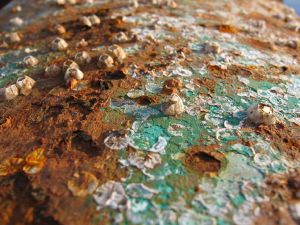
This article follows Martin and Davis in placing Cirripedia as an infraorder of Thecostraca and in the following classification of cirripedes down to the level of orders:[1]
Infraclass Cirripedia Burmeister, 1834
- Superorder Acrothoracica Gruvel, 1905
- Order Pygophora Berndt, 1907
- Order Apygophora Berndt, 1907
- Superorder Rhizocephala Müller, 1862
- Order Kentrogonida Delage, 1884
- Order Akentrogonida Häfele, 1911
- Superorder Thoracica Darwin, 1854
- Order Pedunculata Lamarck, 1818
- Order Sessilia Lamarck, 1818
Notes from crustacea article: Carcinologists have long debated the taxonomic status of crustaceans, sometimes assigning the group to one of the phylum, subphylum, and superclass level, with 5, 6, or even 10 classes recognized (Hobbs 2003). Many also list the Crustacea as a class.
The system used by Martin & Davis 2001 is one system considered by some to be authoritative and superceding earlier works.
Six classes of crustaceans are generally recognized: One of these is : Maxillopoda — various groups, including barnacles and copepods. It contains Mystacocarida and Branchiura, which are sometimes treated as their own classes.
In some taxonomic schemes that consider the Crustacea to be a "class," these divisions are consider to be "orders."
Some biological classification do not recognize Maxillopoda as a class, but recognize the barnacles, copepods, and others as separate classes:
- Cirripedia — sessile grop of crustaceans that are marine and consist of the barnacles.
- Copepoda — mostly marine and can occur in large numbers; millions of copepods may be found in a cubic meter of ocean.
- Branchiura — flattened curstaceans that are temporary parasites on fish.
- Mystacocarida — minute crustaceans restricted to waters of intertidal sand beached and subtidal sand stubstrates, and closely related to copepods (Hobbs 2003).
ReferencesISBN links support NWE through referral fees
- ↑ Joel W. Martin and George E. Davis (2001). An Updated Classification of the Recent Crustacea. Natural History Museum of Los Angeles County.
- Hobbs, H. H. 2003. Crustacea. In Encyclopedia of Caves and Karst Science. Routledge. (accessed December 5, 2006).
- Hughes, N. C. 2003. Trilobite tagmosis and body patterning from morphological and developmental perspectives. Integrative and Comparative Biology 43(1):185-206.
- Martin, J. W., and G. E. Davis. 2001. An Updated Classification of the Recent Crustacea. Natural History Museum of Los Angeles County.
External links
- Rock barnacle at Aquascope
- Barnacles from the Marine Education Society of Australasia
- http://collections.ic.gc.ca/artifacts/kosapsom/images/barnacle.jpg
- http://www.nhptv.org/natureworks/graphics/barnacle.jpg
- Barnacles in Spain Article on barnacles in Spain, and their collection and gastronomy.
Credits
New World Encyclopedia writers and editors rewrote and completed the Wikipedia article in accordance with New World Encyclopedia standards. This article abides by terms of the Creative Commons CC-by-sa 3.0 License (CC-by-sa), which may be used and disseminated with proper attribution. Credit is due under the terms of this license that can reference both the New World Encyclopedia contributors and the selfless volunteer contributors of the Wikimedia Foundation. To cite this article click here for a list of acceptable citing formats.The history of earlier contributions by wikipedians is accessible to researchers here:
The history of this article since it was imported to New World Encyclopedia:
Note: Some restrictions may apply to use of individual images which are separately licensed.
